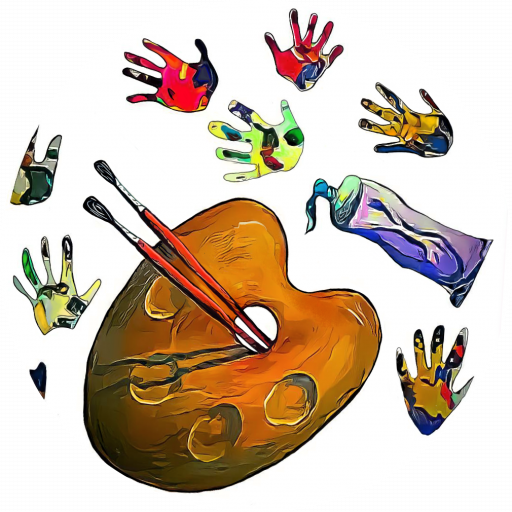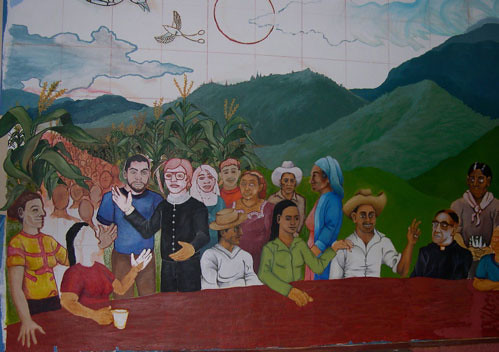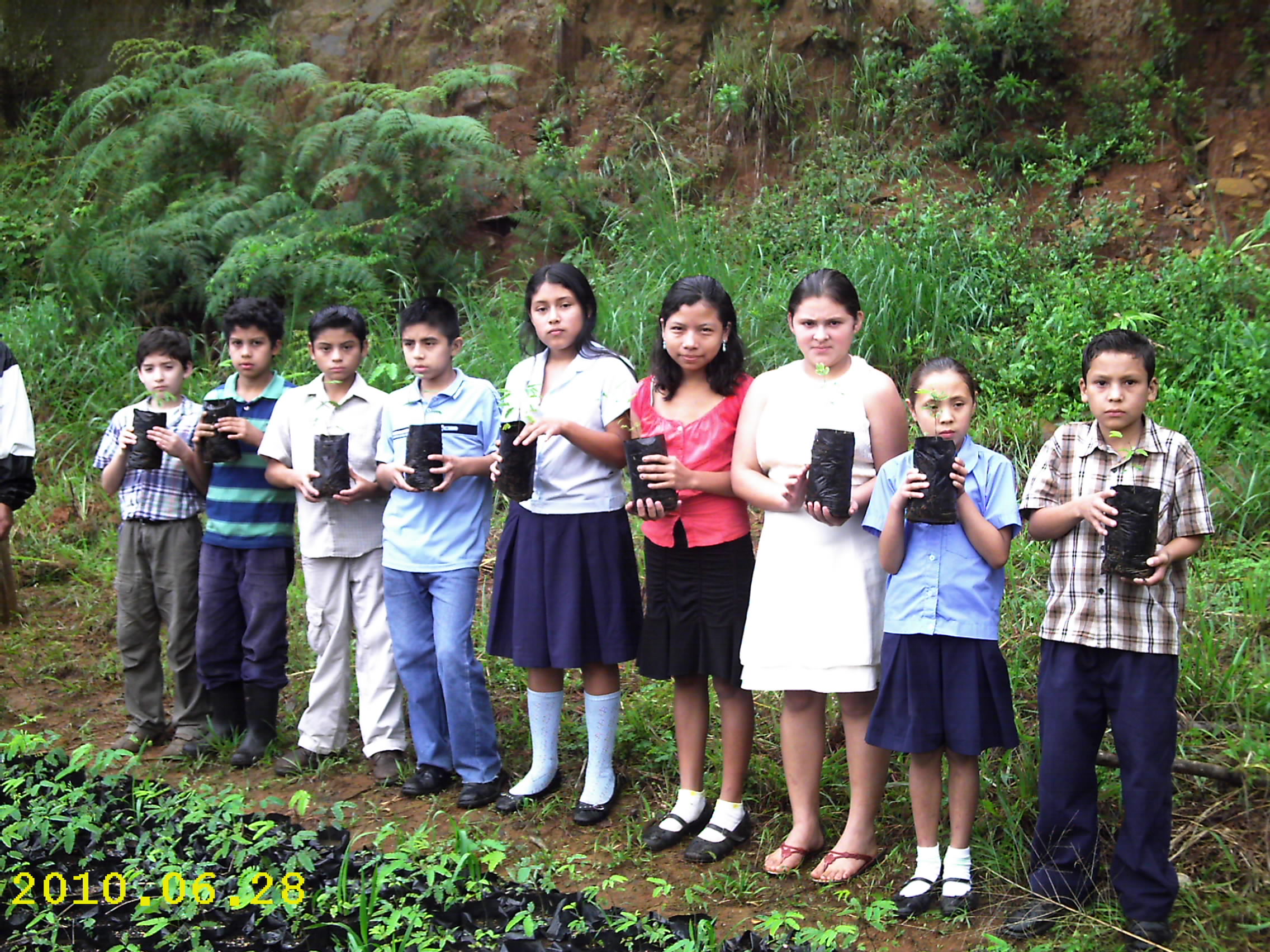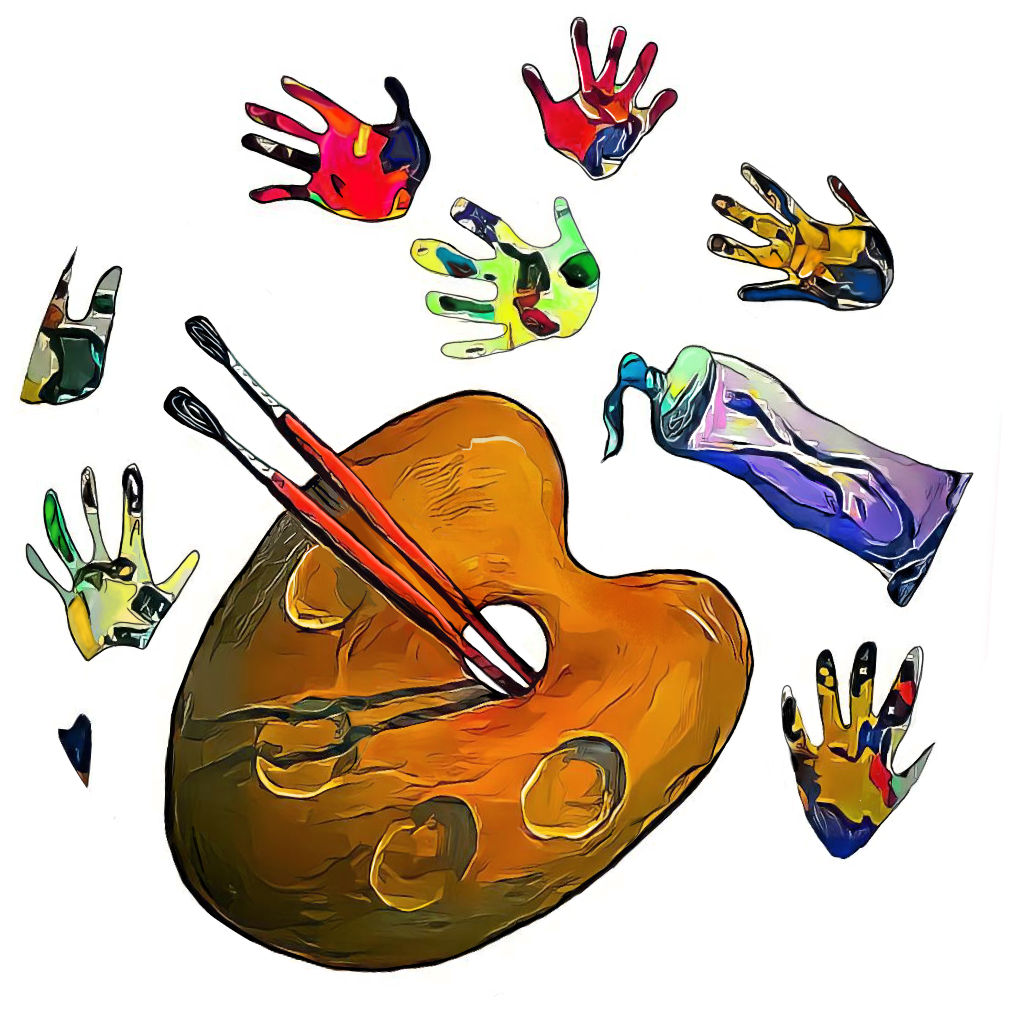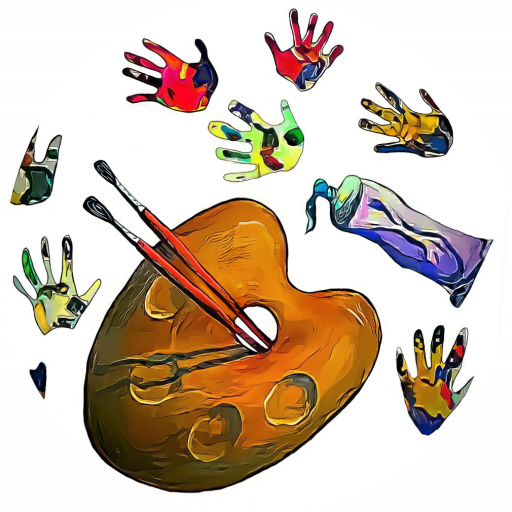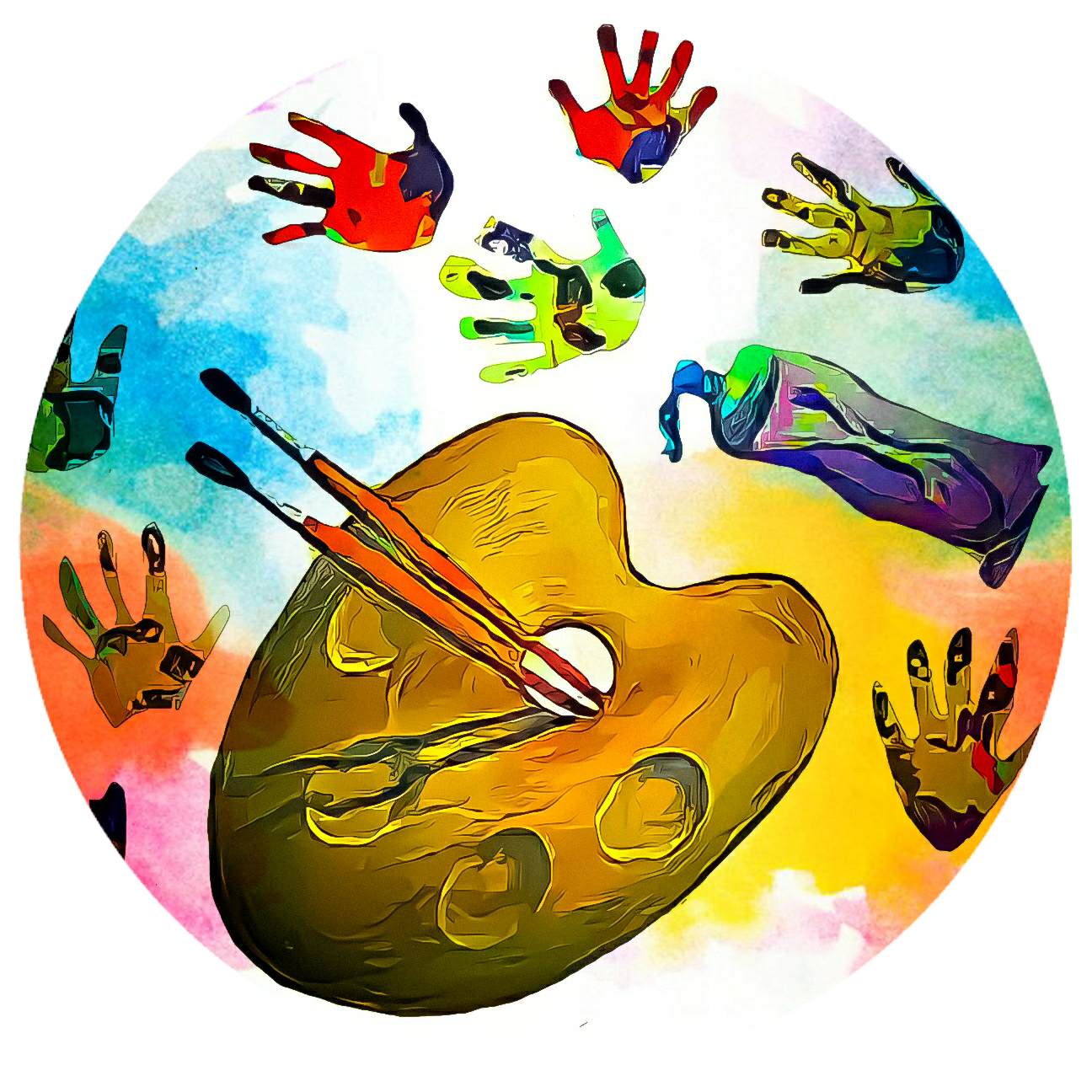October in Perquin finds us all very well, witnessing the remarkable and, hopefully, last huge storms of the rainy season and very busy with the preparation of the events of the 25th anniversary of the massacre at El Mozote.
It is hard to summarize the importance of this last sentence. The multilayered complexity of the lives of the participants of this event shapes the enormity of the historical relevance of this celebration. The potential conflicts due to politics and economic rivalities collide but do not crush in community gatherings where it is being decided who will take responsibility of what part of the celebration.
It is, indeed, a humbling experience and a learning process on how a community comes together even with very evident ideological differences. At the community’s request, with roses and a band of color. It is beautiful!
I measure the success of this project in the way the community of El Mozote receives the murals. The sentence: “Vengan a ver los murales de El Mozote” / Come and see the murals at El Mozote” has rapidly been adopted. It is a reaffirmation for us, artists of this project. Humbly, we see that the art we created collaboratively makes the community of El Mozote proud and willing to share with people outside El Mozote this new aspect of their life.
This is, for all of us, a great success.
August 2006
The Garden at El Mozote:
The Church at El Mozote has two murals. The one painted on the North walls was conceived and created collaboratively between the School of Art of Perquin and the community of El Mozote. The one mural facing the South wall was created and developed by Sister Anna Griffin, Joanna Hopper and the community of El Mozote, mostly the youth. This mural was conceived in the technique of mosaics. The School of Art and Open Studio of Perquin participated in this mural by painting the field of the background and, occasionally, helping with the application of mosaics.
To view photos, please click here: El Mozote Mural Photos
A component of the El Mozote project is the recovering of the only remaining part of the original floor of the building known as “The Convent”, which was exhumed in 1992 by the Argentine Forensic Anthropology Team and where 143 people perished inside its small 35 square-feet surface during the massacre in December of 1981. The sculptural planning of this sacred space was designed upon the reference of the archeological site. Janna Wittenberg, CCa student, participated in this project. There are four iron poles that resemble the exhumation site and above each of them there is an iron flat sculpture that receives the impact of mosaic mirrors. The fragmented image of the viewer intents to remind whoever visits El Mozote, that each of us, could have been a victim or that the victims of El Mozote will forever live within us, among us, making all of us witnesses and disseminators of the facts of this tragedy.
This aspect of the art project has been the most challenging for the community to come to concur upon for it is, undoubtedly, a manifestation of the scale of the massacre. To witness the smallness of the building, with the original floor wounded by holes that are the result of firearms discharged at short range and to imagine that in December of 1981 there were 136 children inside that space is overwhelming. To be aware that no one survived is inconceivable. Sadly, it is prominently a fact.
For the ones in the community who militantly wish to continue remembering, this recovered space is as much homage to the dead, as it is defiance to who is responsible. For the ones in El Mozote who wish not to remember and “turn the page” of history, is a provocation.
The community, Sister Anna Griffin and Joanna Hopper and the artists of the School of Art and Open Studio of Perquin conversed about this extensively and through common agreement it was decided that the space and its painful memory would be retrieved and shared for the thousands of visitors that come to El Mozote knowing that it has become a pilgrimage for many people all over the world.
Sister Anna had in mind the creation of a garden project in adjacency to the Convent and a rose garden to be planted inside the building.
On August 19, 2006, a gathering and celebration took place at El Mozote for the planting of these gardens. Anna and Joanna together with the community had placed the call and invitation through the community radio from Segundo Montes. Everyone who would want to be part of this event would bring a plant, a flower, a tree as part of the communal garden. People were encouraged to make “cuts” of their own gardens and share them in the garden project at El Mozote.
When I arrived to El Mozote with plants of my own garden, Anna was already in the church, sitting behind a computer cataloguing each and all plants that were arriving, identifying who brought what, to what community the plant and the donor came from and how the donors of plants were related to the people who perished at El Mozote.
It occurred to me that a PH D dissertation could be written based on the intricacy of what was being recorded on Anna’s computer! The historical relevance of what was happening, the undeniable tension between the ones who want to remember and the ones who wish to forget (as if one could!), the blood connection to the victims, the issues of land based on that blood lineage which has caused much of the conflict amongst relatives of the dead and, together with that all, the willingness to be part of a poetic, beautiful planting of the Garden of Memory.
In the lower part of the mosaic mural ceramic tiles were placed with edged names of the 136 children who perished inside “The Convent” building in 1981.
The ceremony of the planting of the Garden of Memory brought together:
the relatives of the victims of El Mozote and people who have been closely connected to this history:
•Maria Julia Hernandez and David Morales from Tutela Legal, the human rights agency that has been handling the judicial case since the early 90’s.
• Rufina Amaya Marquez was, of course, a paradigmatic figure in this event.
•It moved me deeply to have been chosen to plant a rose representing both the Argentine Forensic Anthropology Team and the School of Art and Open Studio of Perquin.
In the very place where 136 children, 5 teenagers and 2 adults were exhumed in 1992, a rose garden flowers today. Visitors and pass-byers are invited to see themselves in the mirror and reflect not only about what happened in 1981 but about what happens today and why are we still tolerant regarding issues of violations of human rights in our torn apart world.
On the day of this celebration the community placed two church benches in front of the mural we all painted. They told me that they did so for the people who came from far away to learn the history of El Mozote. The mural has become a history book and a declaration of the community’s wishes for a better and well deserved future.
Penelope Price, dear friend and wonderful film director creator of two documentaries about my work, “Pasa un Angel” and “Artists of Resistance” visited us in July and August. While she was in Morazan, she was generous enough as to create two wonderful short documentaries:
•A children’s class on a Wednesday afternoon in our School of Art in Perquin
•The creation of the collaborative mural project at El Mozote
Thank you, Penelope!!!!! for this wonderful gift of your art to all of us!!!!
Art Exhibition During the Winter Festival
The Winter Festival/ Festival de Invierno, August 1-8, is a big event in Perquin. People from all over El Salvador come during that week to share crafts that craft people, artesanos, bring from their communities and performances of music, dance and singing.
This year we held our second Winter Festival exhibition at the Cultural House, Casa de la Cultura, featuring children’s art work, wood sculpture, textiles, two printmaking projects and paintings reflecting the urban landscape of Perquin and the North of Morazan.
List of Exhibiting Painters
Art Instructor: Claudia Bernardi and Claudia Verenice Flores Escolero
America Argentina Vaquerano, ( Dina)
Ana Guadalupe Márquez Argueta
Ana Isabel Sosa
Claudia Verenice Flores Escolero
David Antonio Claros
Elena Brindidis Chevarría
Eufemia Santiago Iglesias
Gisela Imelda Guzmán Romero
Henry Adalberto Rodriguez
Mayra Guadalupe Orellana Rodriguez
Mélida Argueta
Meymis Guevara Serpas
Nelson Miguel Hernández Guevara
Rigoberto Rodriguez Martinez
Rosa del Carmen Argueta
Wilmer Alfredo Aguilar
Xiomara López Varela
List of Exhibiting Children
Art Instructors: Claudia Verenice Flores Escolero, Rosa del Carmen Argueta and America Argentina Vaquerano, “Dina”
Abner Josué Nolasco Ramírez
Beatriz Gómez Ventura
Carlos Javier Gómez Argueta
Cesar Adolfo Argueta Herrera
Cristian Javier Claros Nolasco
Dania Maideli Ramírez Hernández
Diana Karina Chica Ramírez
Diego Ricardo Vaca Díaz
Douglas Edgardo Nolasco Argueta
Eldi Ameli Guzmán Argueta
Estefani Maurin Ramos Nolasco
Fabricio Dagoberto Ramos Nolasco
Francisco Ernesto Argueta García
Gervin Emmanuel Díaz Argueta
Jacqueline Stefany Guevara
Jonatan Eleazar Nolasco Ramírez
Jonathan Josué Hernández Diaz
Josué Ismael Pérez Hernández
Kelvin Isaac Argueta Guevara
Kimberly Azucena Hernández Nolasco
Kriscia Johanna Guevara Amaya
Leonel Ernesto Méndez Gutiérrez
Lourdes Isabel Claros Nolasco
Natanael Domínguez Pérez
Nidia Lilibeth Nolasco Argueta
Rafael Edgardo Vaca Díaz
Sergio Isaac Vigil Granados
Tita Guadalupe Castro Gómez
Verónica Judith Amaya Vigil
Verónica Mariana Hernández Amaya
List of Exhibiting Youth creating Wood Sculpture
Art Instructor: Rigoberto Rodriguez Martinez
David Rodríguez
Erick Amando Gusman
Ilvin Amando Gusman
José Marquez Rodríguez
José Will Perez Gusman
Rolando Javier Perez Gusman
Ronaldo Sigfredo Martinez Vigil
Ulises Argueta
Exhibiting Textile Artist:
Textile Guest Artist in Residence: Inés Talon
Alejandro Vazquez Vigil, “Quique”
Exhibiting Printmaking Projects:
•Memoria Histórica/ Historic Memory , Part II, A group of 40 young men and women, ages 11 to 25 collected testimonies from the elders about the history of their communities before, during and after the armed conflict. The participants of Memoria Histórica/ Historic Memory borrowed the testimonies of the elders turning them in a portfolio of beautiful and astonishingly powerful woodcuts. The final accomplishment of this project is the creation and publication of a book containing the recovered testimonies and the woodcut images.
•Experimenting Woodcuts: This project was conducted by CCa student Norma Navarro during the month of June 2006. Norma introduced the young artists of Perquin to the technique of woodcuts and taught them how to print on professional Japanese “rice” paper. Both the paper and the wood used in this project were donated by Norma Navarro. Thank you, Norma! for your generous contribution!
One of our wonderful art teachers, America Argentina Vaquerano, “Dina”, is a fabulous painter and art instructor working mostly with the children. She is also a gifted graphic designer who created for us a logo of our school that was used in stationary, presentation cards and a brochure that was disseminated during the exhibition of the Winter Festival narrating the history of the School of Art and Open Studio of Perquin.
During the one-week exhibition we counted more than 600 visitors! In some cases the visitors became students of art classes because every one seemed amazed of the variety and level of the exhibited artwork and every one wanted to learn how to paint, sculpt, draw, print, create textiles, etc.
Media Coverage
Two CCa alumni who came to Perquin last year to work as Artists in Residence collaborated in an article about the School of Art in Perquin. Josué Rojas wrote the article and Ben Flanigan, a film/ video artist, contributed with a wonderful short piece about Perquin and the School of Art.
Please, visit the New America News website:
http://news.newamericamedia.org/
Thank you Josué and Ben!!!!!! for disseminating our work in Perquin through the internet. It has been a great way to make our school be known.
Public Presentations
From August 15 –18, the VI Congreso Centroamericano de Antropología , VI Central American Congress of Anthropology took place in El Salvador. This international gathering of anthropologists, historians, social scientists, political scientists and economists came together to discuss: Centroamérica hacia la Transformación Cultural / Central America towards Cultural Transformation.
http://www.antropologiaca2006.org
The Congress took place at the National University of El Salvador, Universidad Nacional de El Salvador and in the Technical University, Universidad Tecnológica in San Salvador.
I was invited to be a presenter in this congress on August 16. I was part of the forum related to Forensic Anthropology. After having talked publicly for years about the exhumation of the massacre place at El Mozote, I was happy to present about El Mozote from a different angle. My presentation was called:
“El Mozote, 25 years after, Community Gathering and Transformation Through Art”. Prominently, the presentation focused on the community’s willingness to come together to remember and create a neutral ground from which to construct again being the collaborative mural project a manifestation of this new agreement.
It was moving to see the impact of the presented information among the participants of the congress and the public in general. Although the massacre at El Mozote happened not that long ago in this very territory of this small country of El Salvador, it is astonishing to realize that there are many people, especially young people, who do not know about it. The ones, who do know about it, know actually very little and they can hardly place El Mozote in the map of Morazan. Less known even is the community’s activism or the communal painting project in the very place where the massacre occurred.
Students of the National University of El Salvador, with campus in San Miguel, approached me asking if I would be willing to give a lecture about this very topic at their location. I gladly accepted.
It should be remarked that the San Miguel campus of the National University is about 80 km away from Perquin, a distance that can be covered in less than two hours by car and yet, the vast majority of the students and many instructors who came to the lecture admitted to be blissfully unaware of what happened at El Mozote. The effect of the “induced ignorance” among the citizens of El Salvador is as alarming as the similar effect of deliberate absence of information afflicting the United States. It is important to remember that since the end of the armed conflict in 1992, the government of El Salvador has been the ARENA party with strong alliances to the US. It appears to be that the Salvadoran government utilizes similar strategies to cover up actions of questionable nature such as a massacre perpetrated under the agreement of the Salvadoran government, by an elite battalion, The Atlacatl Battalion, trained in the US and supported by the Reagan Administration.
In front of an audience of about 150 people, I presented the facts of the massacre from the evidence gathered at the exhumations of 1992. Heartbreaking images of children’s remains were followed by images of people coming together to paint. The children of El Mozote today were smiling and busy depicting flowers, landscapes and their dreams for the future.
It was agonizingly beautiful.
Many of the people in the audience who could not place El Mozote on the map previous to the presentation made a pledge to come and visit the mural at El Mozote and the School of Art in Perquin.
September 2006
Mary Baldwin College
In September, I left Perquin to respond to an invitation from Mary Baldwin College in Staunton, Virginia. I was awarded a four weeks residency as part of The Elizabeth Kirkpatrick Doenges Artist/ Scholar Program and I was expected to spend the first week of the scholarly residency in September.
It is always stimulating to visit places that one has never visited and meet people one has never met before. This visit to Mary Baldwin College and specially, the meeting of a large number of people was unique in that I felt so dearly welcome and lovingly received, that made me feel that I had been there for a long time! Marlena Hobson, her husband Paul, all the faculty members I met, Dean Edward Scott and President Pamela Fox extended to me their hospitality and warmth in all ways imaginable.
The public lecture on Tuesday September 19 was organized with the participation of Penelope Price who showed her film “Artists of Resistance”. Penelope and I answered questions after the film to a large and attentive audience.
Having seen the positive response to the film that addresses the role of artists as citizens of the world, and after conversing with the art faculty, I proposed that during the second part of the scholarly residency scheduled for May term, the enrolled students and I would paint a mural that would have a community outreach component.
I presented the project to the President Pamela Fox, who was delighted and encouraging. Dr. Fox was eager to find a wall within the college that would receive this community project. I look forward to my next visit to Mary Baldwin College! I am thankful for this opportunity and for the privilege to work in this project!
October 2006
I returned from the US on September 30. On October 2, Marcela Nazzari and Inés Talón, two dear friends and textile artists, arrived from the US and Argentina to create and conduct workshops on textile art.
Marcela Nazzari visited us for the first time. She translated the techniques of her art, prominently based on treated paper, to cloth giving a successful workshop to a group of about 20 women from the North of Morazan
Inés Talon, visits us for the second time. She returns to Perquin to teach workshops in textile art, this time focusing in “back strapped loom” a pre- Hispanic technique that once was practiced in this region. Because of the effects of devastation and fluxes of people exiling outside El Salvador, there are very few places in the country where this textile tradition still exists. Inés brings tools and teaches basic skills using the indigenous fiber “henequén”. She is teaching to two groups of women and few men: one group meets at the house of CEBES, Ecclesial Communities of the North of Morazan, and the other group meets at the church at El Mozote.
Before arriving to El Salvador, Inés conducted a research to reach Salvadoran textile artists. This is how, Inés got in touch with Margarita Lainez and her textile studio “Aracné”. We met Margarita in San Salvador, and it has been a true pleasure to learn more about her, her professional work and her committed contribution to her community. Besides teaching a class of textile art at the University Matías Delgado in San Salvador, Margarita has been teaching a class to a group of about 20/ 25 young men and women from San Sebastian in the state of San Vicente. San Vicente as Morazan, was deeply affected by the impact of the armed conflict reason for which the tradition of textile art has been diminished or interrupted. The work that Margarita Lainez conducts amongst youth in San Sebastian contributes to the possible scenario of developing work opportunities and sustainable enterprises for the participants. We accompanied Margarita Lainez to San Sebastian for a wonderful day trip and met the young participants of her workshops.
Inés Talon was invited to give a talk at the Museo de Arte Popular/ Museum of Popular Art,( inar@navegante.com.sv) in San Salvador on Friday, October 20th where she was welcome with a full house audience who came to hear Inés talk about contemporary textile art and techniques.
At the end of October coinciding with the end of her trip, Inés will close her 2006 visit with another wonderful contribution to us: she will give a weekend workshop in Izalco. Izalco, in the state of Sonsonate, has an ancient tradition in textile art for it was the location where the largest Nahuapipiles indigenous community once lived. Tragically, after the massacre of 1932 known as “La Matanza/ The Killing”, ordered by the Salvadoran president at the time, General Maximiliano Hernandez Martinez, the history, the traditions, the language and the indigenous identity perished, together with 30,000 people massacred in the lapse of few days.
It is of great relevance for Inés to have been invited by Juliana Ama, direct descendant of José Feliciano Ama, the leader who led the indigenous uprising of the “comunas” in 1932, to come to Izalco to teach some of the textile techniques very likely used by the ancestors and forgotten or repressed out of the legacy of their tragic history.
The School of Art and Open Studio of Perquin is honored to have Inés Talon as guest Artists in Residence. We are grateful and indebted for her generosity and her knowledge that has allow us to travel the map of El Salvador “knitting” new connections with textile artists and communities eager to learn the magic and wonders of textile art.
PRODETUR, the local agency of tourism in Morazan has been organizing a series of environment-awareness projects in schools located in very isolated and extremely poor areas of the “Bolsones”. The Bolsones are areas that were adjudicated to Honduras after the Peace Accords in 1992 bringing an enormous political, economic and sociological friction. In a summary, it could be said, that the people who had always lived in the Bolsones consider themselves Salvadorans. However, since the adjudication of that land to Honduras they have become Hondurans. In the meantime, both governments, the one from El Salvador neither the one from Honduras, is taking responsibility for the economic devastation in the area and the total lack of any minimal service or assistance to the inhabitants of this region.
To be clear: it is a region where people live without water, with no electricity, without the most basic health assistance and with impossibility to reach any health assistance area because there is no transportation that gets there, unless it is a private vehicle with 4 wheel drive capacity.
There are, however, few elementary schools, as the one I visited in Joya de Talchiga, the poorest hamlet I ever visited in El Salvador. Two remarkable teachers serve 150 children. I created a small gathering of art and I totally fell in love with the children, the teachers and the area. I am hoping to develop an art project in that area for next year. Transportation is a huge impediment, because if I have to pay a service to get me there they would charge me $ 50 each way! I am now talking to PRODETUR, to see if we could create a joined project that would secure transportation for the art instructors to get to Joya de Talchiga. Claudia Verenice Flores Escolero visited the communities of Cumaro and Pinalitos, where we are also contemplating art projects with the children of those communities for next year.
November 2006
Early in November I will travel to Monaghan, Northern Ireland, to be one of six presenters in an International Conference: Transforming Arts/ Transforming Beliefs
The topic of my presentation will be: ‘Walls of Sorrow/Walls of Hope: El Mozote 25 Years After’ – A study on a community art project in El Salvador that commemorates the massacre of 1000 people in 1981 and the recovery of Historic Memory in the creation of a collaborative mural project in 2006.”
The life of the School of Art and Open Studio of Perquin is being recognized within and beyond El Salvador. We are receiving invitations to present and share with a different range of audiences our community base project that little by little is acquiring the term “Perquin model”.
I am not very happy with the term “Perquin model” because it sounds rather pretentious, but it is true that since March 2005 when the school started until now, we have been shaping a new way to intersect art practice, art education, national and international artists with communities that, by in large, have never had any previous experience with art. The result of this intersection determines that in relatively short time, people who never had any experience in art practice, suddenly do, and not only that, they are able to identify what they want to do, where and how do they want to do it. In many cases, at least in the area where we are, art has served as the most efficient tool of diplomacy.
One project leads closely to another, we are constantly working and designing one full project after the other, so, it is fair to say that I have not had too much time to reflect upon why this happens this way here? Why the School of Art in Perquin has been so successful? Or, whether “the Perquin model” may be implanted elsewhere?
We shall see! This coming year 2007 we have been invited to take part in pilot projects related to art in communities, to human rights and to personal and collective transformation through art.
I will be back from Northern Ireland on November 6. In late November, I will attend a two days conference in Guatemala organized by UNAMG , Union Nacional de Mujeres Guatemaltecas/ National Union of Guatemalan Women. They are creating a conference on the painful subject of “Rape of Women During the Armed Conflict”. I recently met one of the leaders of this group, Olga Paz, who shared with me her desire to organize a series of workshops in art practice designed for the women who are rape victims in Huahuatenango.
On February 21 to 23, 2007, in Antigua, Guatemala, ECAP- Equipo de Estudios Comunitarios y Acción Psicosocial , Team of Community and Psycosocial Actino, ecap@guate.net.gt y ecap@itelgua.com www.ecapguatemala.org is organizing the:
First International Conference on Psychosocial Work in the Exhumation Process, Forced Disappearance, Justice and Truth.
I have been invited by ECAP to conduct a one-week mural project within the context of this conference. The participants will be the survivors of the massacre of Ravinal. Dina and Claudia Verenice will accompany me in this international project.
December 2006
On December 1, the opening of an exhibition of my work is scheduled at the Museo de la Palabra/ Museum of Words. In adjacency to the celebrations of the 25th anniversary of the massacre at El Mozote, this piece titled “Fireflies of El Mozote/ Luciérnagas de El Mozote, will be a multi-media installation that includes sculpture, video and sound sculpture.
December 9, 2006, will be the VERY day of celebration of the 25th anniversary of the massacre at El Mozote. There are many people involved in the planning and in the designing of this paradigmatic event: Padre Rogelio Ponceele, Carlos Henriquez Consalvi ( Santiago ) and Georgina Hernandez from the Museo de la Palabra, Mia Vercruysser from the music ensemble Grupo Morazan, Noé and Ruth Martinez directors of the Grupo de Danza del Norte de Morazan, TNT Theatre, Sister Anna Griffin from Arambala, and the School of Art and Open Studio of Perquin in collaboration with the community of El Mozote.
It is impossible to calculate how many people will attend this event, but the cooks are talking about preparing 8,000 tamales! And likely it is that they may not be enough. We do know that people are coming from all over El Salvador and there are many “internationals” that are making this event a priority and who will join us.
El Mozote’s celebration is, for many of us, a gift of history, it is an incredible recovery, it is a unique proposal of remembrance and community building. The recent history of our violent XX century has, sadly, plenty of similar atrocious episodes that resemble the massacre at El Mozote. In many cases, over time, there has been a recovery of some sort, a “coming together” after the tragedy. It may take several generations for some instance of embetterment to occur. What is unique in the case of El Mozote is that the protagonists are still the same: Rufina is here; Father Rogelio Ponceele who exhorted the inhabitants of El Mozote to leave because he knew about the military operation in the area is here and he still cries when he remembers that the people of El Mozote did not believe that the situation was so severe and decided to stay; Santiago who was the voice of Radio Venceremos and who entered the hamlet of El Mozote days after the massacre to find the scattered parts of bodies decomposing and the stench of death everywhere is here. They all are here.
The time factor is short in this equation and it is, in fact, for that very reason , that is so remarkable that we can come all together to create something out of the ashes of sorrow.
We are transformed by the vicinity to El Mozote in our lives.
August/ September/ October/ November and December 2006
While some members of the School of Art of Perquin travel all over the map in El Salvador and outside the country establishing connections and liaisons with artists and art agencies, the art classes continue to take place at the Casa de la Cultura de Perquin from Monday to Thursday afternoons on regular basis.
Mondays and Thursdays, the “Adults Class” is being held. I should report that the youngest “adult” is 12 years old. Some participants of our children’s classes requested to learn more sophisticated techniques and concepts such as perspective, landscape painting and figurative drawing. We are now investigating how those young eager artists can be integrated in the already established “adults” groups.
Tuesday’s afternoons, Rigoberto Rodriguez Martinez teaches the wood sculpture class to teens and they continue to create marvels!
Wednesday’s afternoons, is our most popular class: the children’s classes, serving over 40 children. Claudia Verenice Flores Escolero and Rosita del Carmen Argueta are the art instructors of this class. Dina and I frequently assist them and help with the implementation of the logistics.
Dina has become our official “documentarist” and taking beautiful photographs illustrating our work in reports and documents.
Friday, is usually, a time to reflect about what worked better during the week, to measure what it may be needed to change, to plan new classes and projects and to share initiatives, ideas and visions.
Besides the already described big event of December 9 at El Mozote, we are busy in our school getting ready for the Final Exhibition of the end of the year. This exhibition’s theme will be “Masks, Me and Us/ Máscaras/ Yo y Nosotros” a full-scale investigation on the way we see ourselves and others, how we construct the way we represent ourselves to our community and to the world.
In this last two months left of this amazing year of 2006, we are happy and ready to transit the wonderful challenges, projects, possibilities and visions of our community translated in art.
Funding:
Our biggest challenge continues to be the funding for this project. We have been able to acquire enough art materials to fulfill art projects during 2007. We are very careful with the art materials and it is part of our teaching ideology to transmit to the participants of our workshops the education on how to take care of the provided materials.
Our biggest need is to secure funding to pay salaries for the wonderful art teachers in this project.
Until March of this year, the previous Mayor and Mayor’s office took responsibility of the payment of my house and other monthly needs that sum up $450. Since April of this year, when the Mayor’s office changed from FMLN to ARENA, the new Mayor did not absorb those expenses, reason for which, those expenses became my own responsibility.
I have decided for this reason to give up the house where I am currently living in December. It pains me, for the house is great! and large enough as to welcome guest artists that live with me when they come as “Artists in Residence” and visitors who come to Perquin to learn and experience the School of Art .
I do not know yet, what will happen from January 2007 on, but I do know that I have not enough funds to continue responding to these expenses that are just “living” expenses. On that, one must add food, transportation (which is a HUGE EXPENSE! Ex: $100 to go from Perquin to San Salvador!), etc, administrative school expenses, etc, etc, etc…..
I would like to end this Report # 7 by thanking again our donors and supporters.
We would have NOT been able to accomplish all the wonderful projects, classes, workshops and community collaborations that I have been describing in this report without their support.
THANK YOU !!!!!!
Potrero Nuevo Fund
San Carlos Foundation
Mara Foundation
And donors who have sent their collaboration to Intersection for the Arts.
I would like to thank Yasenia Sánchez, who manages the funds arriving to Intersection for the Arts and who was kind enough to send me the following list of donor’s names:
Read
Papa/Brown
Groundspring: anon
Escolani
Arellano
Groundspring: Barger
Groundspring: Lorenc
Groundspring: Imperatore
Groundspring: anonymous
Curry-Evans
Cook
Carrillo
Arellano
Hernandez-Larin
Hernandez-Larin
Grossfeld
Scott
Novak
Sauer
Seto
Seto
Mantecon
Sweigert
Duscha
Sun Sierra
Sun Sierra
Cowan
Groundspring: Webb
Lopez: Walls of Hope
Schell: Walls of Hope
Jones: Walls of Hope
King: Walls of Hope
Kellerman: Walls of Hope
Virginia Hewson: Groundspring reimburse from IFTA
Dick Watts: Groundspring reimburse from IFTA
Mary McGann
Hispanics in Philanthropy
Christopher and Deborah Lorenc
Christopher Lorenc
I would like to thank Deborah Cullinam and Kevin Chen from Intersection for the Arts and all dear friends of that fabulous art agency for their constant willingness to accompany this beloved project :
Walls of Hope/ The School of Art and Open Studio of Perquin
With our most dear regards from Perquin
And many hugs!
Claudia Bernardi
